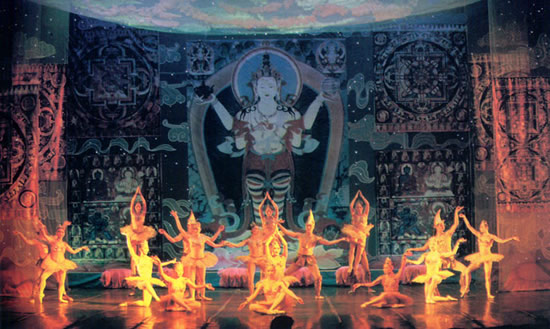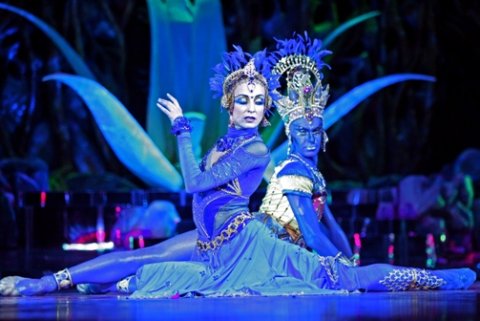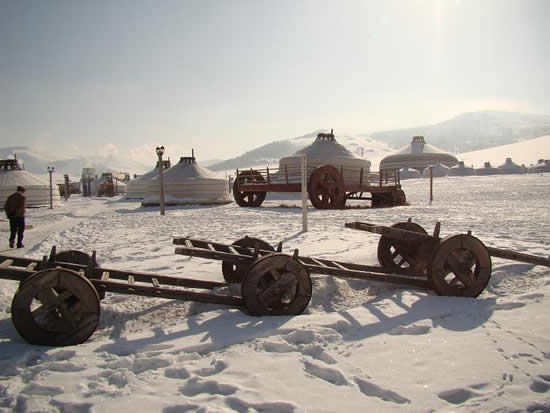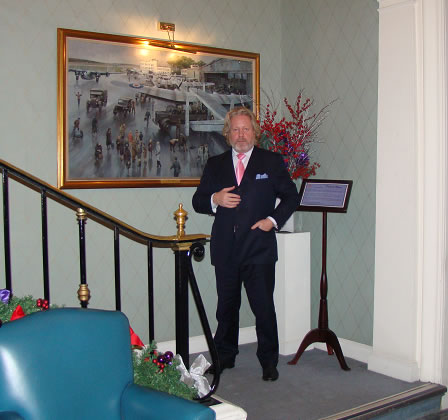One of the things about running a business with numerous offices across China, India and elsewhere in Asia is that it’s almost impossible to escape the huge numbers of people. Heaving masses of humanity – the great unwashed – in both China and India can, after a while, leave ones inner peace somewhat frayed around the edges. Also, as I intend to spend more time writing over the next few years, I need somewhere quiet. No dogs barking, no telephones ringing, and no constant traffic hum in the background.
The Choijid Tara – A Mongolian Ballet Masterpiece

The Choijid Tara (“Buddhist Goddess”) is a revered figure in Mongolian Buddhism, and a production of a new contemporary ballet for the State National Ballet of Mongolia – it’s first in over fifty years – has delivered a contemporary masterpiece. Based upon the Buddhist story of the young girl Choijid, this completely new commission, to music by Mongolian composer E. Choidog, scored for Western orchestra, and with choreography by B. Jamyandagva (libretto by Sh. Surenjav) represents the essential Buddhist beliefs of this deeply religious country, and provides what may well be the only Buddhist ballet currently in performance. As a devotee of Les Ballets Russe, I am always mindful of Serge Diaghilev’s famous words to new works by composers and choreographers – ‘Astonish Me!” The ballet Choijid Tara has astonishment, beauty and drama that really I felt was up there with the best of Stravinsky’s marriage of music to movement. Russian trained Jamyandagya himself is Mongolia’s first ballet master and the Father of contemporary ballet in the country today.
Assigned Barony of Coigach

It’s not everyday one becomes titled; and certainly not to a title that has existed for 500 years. Yet that is exactly what has happened, I’ve just been assigned the Barony of Coigach from the Earl Cromatie in the Scottish Western Highlands. Coigach itself is an estate of some 145,000 acres, with the Barony being created in June 1511. The assignation has been completed with the Scottish Barony Register and accepted by the Lord Lyon, the Queen’s representative for Scotland. Next step is I need to apply for a new coat of arms – these are granted to individuals so I cannot inherit the previous one. To that end I have employed the services of a heraldic expert in Edinburgh to assist with the design; it’s quite an art. Heraldry has specific rules over what can and cannot be displayed, and they should identify the individual. They also have to be submitted to the Lord Lyon for approval, who if successful will enter the arms into the Scottish heraldic registry. I’m working on this project now – rather different from the usual contract reviews and spreadsheets I have to evaluate !
The Return Of Les Ballets Russe

Les Saisons Russes du XXI Siecle (The Russian Season in the 21st century) is a ballet programme and tribute to Serge Diaghilev’s Ballet Russe, which for twenty years in its original format between the two world wars held the social season in London, Paris, Monte Carlo and other cities in its thrall. Bringing together the best of the Russian immigres fleeing the Bolshevik revolution, it introduced the classicism of Russian Court ballets to the new and avant garde. Ballet stars whose names still reverberate today – Nijinsky, Balanchine, Fokine, Pavlova, along with set designers including Salvador Dali, Jose Miro, Leon Bakst & Pablo Picasso, mixed in with a dash of Coco Chanel, Natalia Goncharova and Henri Matisse. And that is without mentioning the music, often specifically commissioned. Stravinsky, Prokofiev, Debussy & Ravel, plus many others. Stravinsky’s works with the Ballet Russe especially are now considered genius – Firebird, The Rite of Spring are still in the repertoire today.
The Ballet Russe closed in 1929 when Diaghilev died suddenly, and although a whole host of revivals, most notably “Les Ballets Russe De Monte Carlo” kept the name burning, by the Second World War it was all over. No films were ever shot of the performances – Diaghilev had forbidden this – and in the chaos of war much of the material such as choreographic notes, costumes and sets were lost. Les Ballet Russe, it seemed, was lost to remain a memory and faded programmes. Step forward, however, Andris Liepa, a world ballet star and son of one of Diaghilev’s choreographers Maris Liepa. In research that has taken over 20 years, lost ballets have been painstakingly recreated from old reviews, photographs and from interviews taken from the few remaining dancers still alive, many of them now in their nineties. Where gaps in the choreography have remained, this have been filled in with new work by Liepa and Jurius Smoriginas.
Gergiev Conducting Turandot at La Scala
My Spring Europe / India tour is underway, with speaking business engagements in several cities over the next four weeks. However, I also try and coordinate these with cultural activities, and just this next week alone I’ll be taking in two operas and seven ballets between Milan and London. Russia of course rules the roost as my preferred theatrical style, yet with an Italian wife and living in Beijing, a trio of Valery Gergiev conducting at La Scala in a Premiere, new performance of Puccini’s “Turandot” – set of course in the Forbidden City – cannot be missed. Gergiev of course is the Russian Maestro almost single handedly responsible for dragging Russian culture out of its Cold War prison and back into the international repertory, which is partly the reason why once again the likes of Tchaikovsky, Prokofiev, Rimsky-Korsakov and the enfant terribles of Stravinsky and Shostakovich can still be often heard today.
Celebrating Nowruz, the Kazak First Day Of Spring

Mongolia has always had a sizable ethnic Kazak population – after all it shares a long western border with the country. This meeting of nations brings Islam to Mongolia, which is why in the far west in places such as Bayan Olgi you’ll find Mosques. The Kazaks have different traditions too – even their Gers (Yurt in Kazak) have slightly different appearance. Nomads like the Mongolians, they do however favor the use of eagles in hunting, and an annual eagle festival is held each autumn in Bayan Olgi. Today though I am in Ulaan Baatar, looking after my property development, and on March 22nd the Kazaks celebrate Nowruz – the first day of spring.
Gergiev At The Suntory, Tokyo
Nowadays I tend to plan my business trips around operatic performances, and especially when the opportunity arises to catch Valery Gergiev conduct the Marrinsky Orchestra. Whenever he and they are in Asia – we go, that’s the rule. It’s a great way to get some unexpected trips, but as maestros such as Gergiev are booked out months in advance, it’s also possible to plan trips to coincide. In October, for example, I’ll be having business meetings in the day in New York, while shuffling off to see a week’s worth of Tchaikovsky symphonies at the Barbican every night. That’s the way to combine business with pleasure in my opinion. Fortunately, Tokyo is not so far from Beijing, so it was an early spring that greeted us – although we did manage to catch on day two the worst snowfall in the city for ten years. Tokyo in snow is also a sight to behold, and we took the opportunity to take shelter in a number of tiny sake bars on the way home.
The RAF Club, London

One of the pleasures of London is clubland, where I am fortunate to belong to through my long standing membership of the Royal Overseas League. Founded in 1910, the ROSL celebrated its 100th anniversary last year, and it has long been a stalwart for expatriates returning to the UK after postings abroad. In those days, being an expat meant a serious commitment – to the Far East, where I am (Beijing) would be a three month voyage just to arrive. Clubs such as ROSL, granted Royal Charter by King George V in 1916 and continued by every British Monarch since; provide a home from home in the center of London, ideal for when I do return back to Albion. While others may book the Hilton, or even the Ritz or Mandarin Oriental, ROSL is sited bang on St. James Park, and provides accommodation, an excellent bar, reading rooms, a library and two very good restaurants all for a fraction of the price of commercial establishments. Only open to members, I can relax away from the commercialization of staying in an hotel, and potter about as if in a very grand stately home of my own. It’s also within walking distance of Covent Garden, Piccadilly Circus, Harrods, the great museums of South Kensington and Jermyn Street, home to tailors and hatters since the 1600’s. That’s all well and good while I live it up as a Lord, however the best kept secret of London club memberships are the reciprocal arrangements.
The Kew Gardens Chinese Pagoda
As a boy, I spent a lot of time in London, my Father worked for the BBC, so the necessity of being close to central London and BBC House was paramount. One of the joys was spending weekends bicycling to Kew. These are Royal Gardens, famous for their botanical science and research and for housing the worlds largest greenhouses. The importance of the botanical gardens cannot in fact be underestimated – a Victorian ideal, some of the specimens brought back by Charles Darwin and Edgar Wallace on their respective adventures are still alive and well and growing in the various hothouses at Kew. It’s a remarkable testament to these early botanists and naturalists that their specimens survive and are still studied here.
However it was the Pagoda that always enthralled me. Years before I ever went to China (I’ve now lived in the country for over twenty years), the Pagoda seemed like an alien transplant from an almost imaginary Orient. The mysteries of Cathay stood there, almost timeless, in front of me, ever since I can remember. Whenever I am back to London, I always pay it a visit.
Cheers To Hemingway!
It’s always a great pleasure to be in Paris, coming especially as I do with partially Gallic heritage. It’s an even greater privilege to take cocktails at the Paris Ritz Hotel . My good friend Colin Field, an Englishman in Paris, is the head barman at the Hotel, and is famous for having invented the most expensive cocktail in the world. He’s also acknowledged as one of the Greatest Barmen in the world (Forbes, amongst many others) so a trip to Paris is never really complete without paying him a visit. His recent book “Cocktails of the Ritz” also features an introduction by Kate Moss, such is his pulling power (I’m lucky if I get the Head of Shanghai Amcham for mine). The Ritz is also cool for another reason – it was liberated in World War Two from the occupying Germans by Ernest Hemingway. Working as a war journalist and attached to an American infantry division, they fought their way into central Paris and eventually to the Place De Vendome. One suspects the Germans may have fled by this time, but Hemingway piled into the hotel with his troops – the German High Command for France had been billeted in the hotel during the occupation – walked into the “Small” bar to the side of the entrance and announced to the somewhat nervous barman stood there "I’m Ernest Hemingway with the US Army and we are liberating this hotel! A round of dry martinis for all the men on me please!"
That small bar is now the Bar Hemingway, named in his honor, and features a collection of artifacts from the great writers day – including his portable typewriter and many photos. Colin has now embellished this with collections of his own – a keen huntsman, Colin’s trophy bags of various deer, wildebeeste and other such creatures stare down balefully at the drinkers beneath. However, its his Ritz Sidecar that really takes the breath (and the credit card) away. It is the classic mix of Cointreau, brandy and lemon juice. However, Colin makes one with a rare 1830 reserve cognac, of which there are only a few bottles left worldwide. It’s uniqueness lies in the fact that the grapes from which it is made of were collected before the invasion of phylloxera, a pest that destroyed valuable varieties of grapes in France in 60’s before the last century. It’s also priced at USD1,400 a glass. I was allowed to cuddle the cognac bottle for a few seconds however.